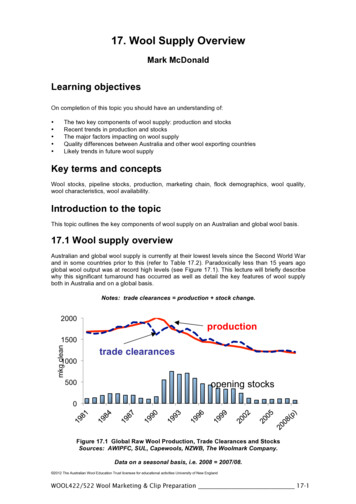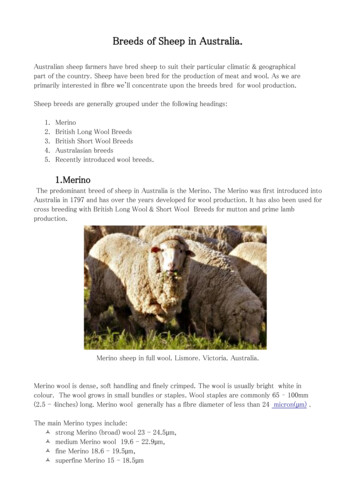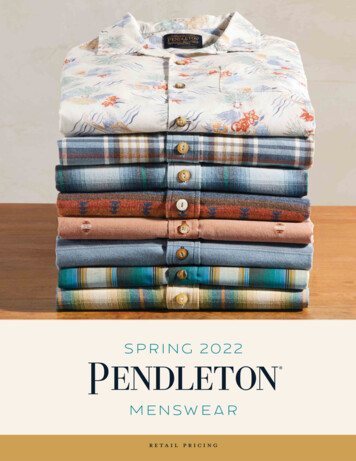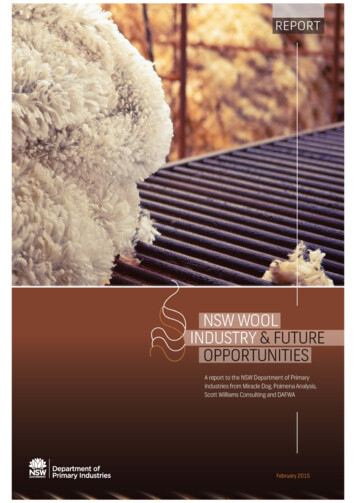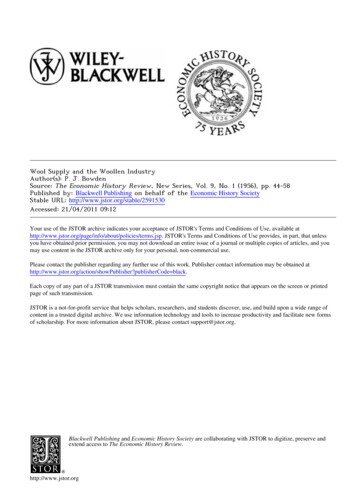
Transcription
Wool Supply and the Woollen IndustryAuthor(s): P. J. BowdenSource: The Economic History Review, New Series, Vol. 9, No. 1 (1956), pp. 44-58Published by: Blackwell Publishing on behalf of the Economic History SocietyStable URL: http://www.jstor.org/stable/2591530 .Accessed: 21/04/2011 09:12Your use of the JSTOR archive indicates your acceptance of JSTOR's Terms and Conditions of Use, available at ms.jsp. JSTOR's Terms and Conditions of Use provides, in part, that unlessyou have obtained prior permission, you may not download an entire issue of a journal or multiple copies of articles, and youmay use content in the JSTOR archive only for your personal, non-commercial use.Please contact the publisher regarding any further use of this work. Publisher contact information may be obtained at erCode black. .Each copy of any part of a JSTOR transmission must contain the same copyright notice that appears on the screen or printedpage of such transmission.JSTOR is a not-for-profit service that helps scholars, researchers, and students discover, use, and build upon a wide range ofcontent in a trusted digital archive. We use information technology and tools to increase productivity and facilitate new formsof scholarship. For more information about JSTOR, please contact support@jstor.org.Blackwell Publishing and Economic History Society are collaborating with JSTOR to digitize, preserve andextend access to The Economic History Review.http://www.jstor.org
WOOL SUPPLY AND THE WOOLLEN INDUSTRY'BY P. J. BOWDENIOF the many consequences of the enclosuresfor sheep-farming in Englandprobably none was more far-reaching yet received less publicity thanthe changes effected in the character of the English wool supply. Inher well-known study of the medieval wool trade the late Professor EileenPower sought to establish the existence in the Middle Ages of two main breeds ofEnglish sheep, these being distinguished by the length of the staple of their wool:There was a small sheep producing short wool, prepared by carding and usedto make cloth. Larger sheep produced long wool, prepared by combing andused for lighter worsted and serges.The short-woolled sheep was the native of poor pastures, hills, moors anddowns. The long-woolled sheep belongs to rich grasslands, marshes and fens.The great bulk of the fine wool exported in the Middle Ages came from twolong-woolled breeds, Cotswolds and Lincolns and, some way behind, Leicesters,which were probably common to most of the Midlands.2It will be shown later that the production of long-staple wool in England in theMiddle Ages was, at the most, negligible, there being no true long-woolled breedof sheep in England at this time. Consequently, the overwhelming bulk of woolexports-andall fine wool exports-wereof short-staple, and not long-staple,wool. Even if Professor Power's description of sheep breeds were applied to theconditions of the sixteenth and seventeenth centuries, when increasing quantitiesof long-staple wool were being produced, it would still require very considerablequalification.In the first place, the classification of sheep into long-woolled or short-woolledbreeds, though convenient, tends to obscure two important considerations.First, it implies a clear-cut division between long- and short-staple wool whichprevious to the eighteenth century did not in fact exist. Many Norfolk sheep,for example, produced a 'middle' wool which, while too short to fall into thecategory of long-wool proper, was long enough for use in the manufacture ofworsted fabrics, though short enough to be used in the making of coarse cloth.3Secondly, fleeces were never of a uniform length of staple or fineness throughout.Long and short wool, coarse and fine wool might all grow in the same fleece,though in different proportions;4 and a long-woolled fleece, for example, wouldbe one in which long-staple wool predominated.1 Based on a section of my Ph.D. thesis, The InternalWool Tradein Englandduringthe Sixteenthand SeventeenthCenturies(Leeds University, December I952).2 E. Power, The Wool Tradein English MedievalHistory (Oxford, I94I),pp. 2I-2.3 The coarseness of the wool grown in Norfolk and its poor felting property made it unsuitablefor the manufacture of fine broadcloth, and, until at least the beginning of the seventeenthcentury, it was worked up chiefly into worsted and, to a lesser extent, into coarse cloth. SeeStatute 33 Henry VIII, c. i6; P.R.O. E. I34/44-5Eliz. Mich. I; S.P. I4/80/I3.4 P.R.O. S.P. I 6/5 I 5/ I 39; W. Youatt, Sheep, TheirBreeds,Managementand Diseases (ed. I 890),p. 66. There were other ways in addition to fineness of fibre and length of staple in which woolscould vary from each other. They could, for instance, differ in 'trueness' of staple, in strength offibre, in softness, in elasticity and in colour. A consideration of these matters, however, lies outside the scope of this paper.
WOOL SUPPLY45Bearing these considerations in mind, the main differences between longwoolled and short-woolled fleeces in the sixteenth and seventeenth centuries maynow be mentioned. The first and most obvious difference was in the length of thestaple of the bulk of the fleece. The staple of long-wool proper was six inches ormore in length: that of 'middle' and short wool proportionately less. A longwoolled fleece being longer, and often coarser, than a short-woolled fleece, wasalso heavier. Its weight might have been anything over 4 lb. The short-woolledfleece, on the other hand, might have weighed as little as i lb. In the sixteenthand seventeenth centuries, the fine wool of the Rylands breed did not normallyweigh more than I lb. in the fleece,' and even in the nineteenth century rarelyexceeded 2 lb.2 The fleece of other short-woolled breeds was somewhat heavier.In the early Stuart period that of the Sussex and Hampshire sheep normallyweighed 2 or 3 lb.3 while the sheep owned by Henry Best, one of the minor gentryof the East Riding, produced a fleece of about the same weight.4 Finally, onefurther main difference between long-woolled and short-woolled fleeces may bementioned. The wool of the former was more diversified and thus requireda much greater amount of sorting than was the case with the short-woolled fleece.Various influences determined the fineness of wool and the length of staple.Of these, temperature, if not the most powerful, was certainly not withoutsignificance. According to Youatt, who wrote in the nineteenth century, 'thenatural tendency to produce wool of a certain fibre being the same, sheep in a hotclimate will yield a comparatively coarse wool, and those in a cold climate willcarry a finer, but at the same time a closer and warmer fleece'.' When sheepwere starved, however, extreme cold was injurious to the quality of the fleece,and it became coarse, or lost much in weight, strength and usefulness.6Pasturage had a far greater influence than temperature upon the fineness ofthe fleece and the length of its staple. The more nutriment which a sheepreceived the larger it became. The staple of the wool was no exception and likeevery other part of the animal, increased in length and bulk as a result of betterfeeding.7 The difficulties experienced by farmers in providing sufficient grazingand fodder for animals under the open-field system of agriculture are too wellknown to need elaboration here. The common wastes, the corn-stubble left afterharvest, the very limited supplies of hay and straw in the winter supplementedby the leaves of common forest trees made the scantiest feeding; and the pressureupon these resources as the autumn drew on made it possible for the farmer tomaintain little more than the breeding stock and the young stock needed toreplenish flocks and herds. The enclosures for sheep-farming made life easier,both for the farmer and his sheep. As Lord Ernle has already stated, 'asenclosures multiplied, sheep were better fed, and the fleece increased in weightand length though it lost something of the fineness of its quality'.8 Thus2 Youatt, op. cit. p. 258.V.C.H. Herefordshire,I, 409.CommonsDebates,1621, ed. W. Notestein, F. H. Relf, and H. Simpson (New Haven, I935),VII,499.Rural Economyin Yorkshirein 1641, beingthe Farmingand AccountBooks of HenryBest (Durham,Surtees Soc. i857), p. 24.5 Youatt, op. cit. p. 69.6 Ibid. p. 70; An EnquiryintotheNatureand Qualitiesof English Wools,By a GentlemanFarmer(I 788),4p. i8.Youatt, op. cit. p. 70.R. E. Prothero (Lord Ernle), English FarmingPast and Present(i9i2), p. 8i. It is apparent,however, that Lord Ernle did not fully realize the significance of these changes in the wool supply,as he also held the common view that English wool exports during the fourteenth and fifteenthcenturies were mainly of long-staple wool (ibid. pp. 78-80).8
THE ECONOMIC HISTORY REVIEW46throughout the sixteenth and seventeenth centuries there was a gradual diminution in the supply of fine, short wool grown in England and an increase in thesupply of longer and coarser wool.The influence exerted by enclosure upon the quality and length of wool,however, varied considerably in different parts of the country. It was moststrongly felt when it took place upon land which was potentially deep and richpasture. In England, such land was concentrated mainly in that V-shaped arearunning from Wiltshire in the south-west to Norfolk in the east and the EastRiding in the north where the open fields persisted the longest and still remainedthe dominant system of agriculture at the end of the sixteenth century. Here thebulk of the country's fine wool supply in the Middle Ages was produced. Buteven so, this area had been the centre of the enclosure movement of the midfifteenth century onwards, and ever since that time it had gradually beenincreasing its production of longer and coarser wool. Outside this area enclosurehad, for the most part, taken place much earlier. But here grasslands were lessluxuriant and feeding poorer. Consequently, enclosure in these parts had noteffected the same radical changes in the type of wool produced as it later did inthe mainly Midland area already mentioned.As we have seen, the influences of pasture and temperature largely determinedthe characteristics of the wool produced by breeds of sheep native to particularareas. Given time, the same influences could also effect changes in the type ofwool produced by alien breeds. Coarse-woolled sheep from Wales and other'outward' places had been used for stocking some of the lands which wereenclosed in the Midlands during the late fifteenth and early sixteenth centuries.According to one commentator, the result of this had been that 'ther corse wollechaungith to staple wolle, but not so pure fyne wolle like as in old tyme it wasreceyvid by werks of housboundry'.1 Despite the influence exerted by pasture,however, the intermingling of sheep bred on enclosed and unenclosed lands,such as might occur, for example, when a farmer purchased new stock, must,over a period of years, have had some effect, if only slight, on the character ofwool produced under the open-field system of agriculture.IIThe effect which enclosure was having on the quality and weight of wool wasnoticed by some contemporaries. Thus an early sixteenth century critic of theenclosure-movement stated:. the shepe to receyve that gift of fynes and godnes therof must nedes fede ofthe leyres of the erthe like as in old tyme (when) the erth was wrought andopenyd by tillage. So as than was it pure fyne woll, oon pownd worth twonow, because the erthe is now putt to indulnes to bryng forth rant, foggye, wildgreese, wherupon the shepe of the hyghest of the greese receyvith ther fedyng, soreceyve they rank, wild heyry wolle, in that they cannot come to the leyr oftherthe. So is the gift of fyne wolle yerly lost to the great hurt and sclander ofthe reame.2Ied. R. H. Tawney and E. Power (1924),Documents,TudorEconomicIII, 101.Ibid. The deterioration in the quality of wool as a result of enclosure was quite widelyadmitted in the eighteenth century. See E. C. K. Gonner, CommonLand and Inclosure(1912),pp. 340-342;An Enquiryintothe:Natureand Qualitiesof English Wools,pp. 17-22; Hist. MSS.Comm.MSS. p. 303.Buckinghamshire2
WOOL SUPPLYCommented another writer in47I6I0:In those daies before the trobles wee had not so muche woolle growinge as weehaue nowe, for that men covet to haue sheepe which beare great burdens so thatone sheepe beareth as muche woolle as twoe or three did in those times, beingnowe all pasture sheepe, and heeretofore many were fielden sheepe. I3, I4, I5and i6 used to bear a tod nowe 4 sheepe doe it.'Surviving references by contemporaries to the changes effected by enclosureon the character of the sheep's fleece are, however, few-so few in fact that theirsignificance has completely escaped the attention of economic historians. Indeed,there might seem good reason for viewing even these references with scepticismwere it not for the fact that they are borne out by an overwhelming weight ofsupporting evidence.Though the reason for the deterioration in the quality of the wool supply doesnot appear to have been generally understood by English textile manufacturers,it did not pass completely unnoticed by them. Thus, in I586, West Countryclothiers, who obtained the bulk of their wool supplies from the Midlands,complained, 'the grosenes of wolles in England' hath 'much encreased . withintheis tenne yeres or theiraboutes ',2 and this refrain was later taken up by WestRiding manufacturers with particular reference to Lincolnshire wool.3 The maincriterion of high-quality wool was fineness of fibre, and the finest wools commanded the highest prices.4 Further evidence of the deterioration in the qualityof the wools grown in the Midlands and Lincolnshire can therefore be obtainedby comparing price-lists of English wools at different dates. A number of suchlists covering the period between the mid-fourteenth and the end of the sixteenthcentury are available,5 and these show a downward trend in the relative prices ofwools grown in the Lincolnshire and Midland areas. As the wools produced inthese parts became coarser, other wools which had not previously been highlyregarded began to be held in greater esteem. Hampshire wool, for example, hadnever enjoyed any great reputation in the Middle Ages, but by the middle yearsof the seventeenth century it was considered to be one of the finest clothing woolsin the country.6 The wool produced on the Sussex downs, which had been not at1 B.M. Lansd. MS. 152 (fol. 229). Considerably earlier than this, some contemporaries wereaware that pasture sheep gave a greater amount of wool than those grazed on the commons andopen-field stubble. See, for example, the statement: 'Allowed to every Todde xx sheere shepe,because it is thought that ther was not so many pasture sheep in the tyme of Edward III as benowe, but most were kept on the Comens.' For the year of writing (I547) the number of sheepper tod was estimated at I5. (TudorEconomicDocuments,in, i8o.) See also CommonsDebates,1621,V1I, 499, for comments on the increased production of heavy fleeces in Oxfordshire, Worcestershire and Buckinghamshire.2 B.M. Lansd. MS. 48/66 (fol.I57).3 In a law-suit of i638, it was deposed: 'The kersies ordinarily made in the viccaridge ofHalifax twenty and thirty yeares agoe were made of better wooll then the kersies there nowordinarily made are. And sayeth that the wooll now brought out of Lincolneshire is not so goodas was brought theare into the said parish about thirty yeares since' (P.R.O. E. 134/14 Car. I.Mich 2 I).4 Professor Mantoux's statement that long-staple wool was of 'better quality and higherprice' than short-staple wool (P. Mantoux, The IndustrialRevolutionin the EighteenthCentury(tr. M. Vernon, ed. 1947), p. 67) is, in the main, inaccurate.5 Foedera,ed. T. Rymer (I708),V, 369; Rolls of Parliament,32 Henry VI (printed in J. E. T.Rogers, A Historyof AgricultureandPricesin England(Oxford, i886), III, 704); Calendarof LettersandPapers, Foreign and Domestic, Henry VIII, IX, 409; Hist. MSS. Comm. Salisbutv MSS. xIII,54-5; P.R.O. S.P. 1/102, fols. I-2; S.P. 121154/30.6 P.R.O. E. 134/14 Car. I. Mich. 20; England'sGlory,by the Benefitof WoolManufacturedtherein(I669),p. II.
48THE ECONOMIC HISTORY REVIEWall distinguished for its quality before the seventeenth century, was highlypraised by one authority in I706.1 Even the contemptuous 'Cornish hair'2 ofbygone days was stated in I582 to be 'verye good and much bettere and plentyfullere then in tymes past '.English wool had been unsurpassed for fineness in the Middle Ages, but as itsquality deteriorated so did Spanish wool gain in estimation. Already in theearly sixteenth century it was noticed that English wool was losing its reputationfor fineness to Spanish wool,4 and by the end of the century the latter was almostcertainly superior. The decline which occurred in the English wool export tradeduring this period was undoubtedly largely due to the pressure of home demandand the relatively high price of English wool in the foreign market, but a notunimportantfactor in the decline of overseas demand for finewool may well haveIndeed,been the deterioration in the quality of the English fine-wool supply.5the continental cloth industry found so little need for English wool in I 6io thatit could be said, 'the woolles of Spayne serve their owne contry all France andItaly and the Netherlandes, and our woolles not once asked after, except weewould suffer our sortes of woolles to passe, which maketh our bayes, sayes,After the mid-seventeenth century noand other stuffes of that natureeven English writers could deny that Spanish wool was the finest in theworld.7Further evidence of the changes which were taking place in the character ofthe English wool supply is provided by information relating to the weights ofMidland and Lincolnshire fleeces and the different uses to which these were putin the sixteenth and seventeenth centuries. As already stated, a long-woolledfleece weighed at least 4 lb. Yet in the thirteenth century the average weightof a large sample of Lincolnshire and Northamptonshire fleeces was onlyI lb. I412 oz.8 Even in the sixteenth and seventeenth centuries, when enclosureswere resulting in the production of increasing quantities of long-staple wool,many of the fleeces grown in the Midlands and Lincolnshire were too light to havebeen the produce of long-woolled sheep. In 1586, for example, the averageweight of fleeces produced by the sheep of one Oxfordshire grower was 32 lb.,9J. Haynes, A Viewof the PresentState of the ClothingTradein England (I 706), p. I4.E. Power, 'The Wool Trade in the Fifteenth Century', Studiesin English Tradein theFifteenthCentury,ed. E. Power and M. M. Postan (1933), p. 49.3 TudorEconomicDocuments,i, 194.4 Ibid. III, I102.5 Two ways of meeting the competition of Spanish wool were open to English wool exporters.There was the most obvious method, which seems to have been attempted particularly during theearly decades of the sixteenth century, of specializing in the export of the very finest types of woolso that a proportionately smaller part of the value of the wool was paid in customs. This wascut-throat competition, and the Staplers waged a losing battle. They endeavoured to offset partof this loss by concentrating more on the export of longer and coarser wool for which, at leastduring the first sixty years of the sixteenth century, there was a limited, but expanding, demandby the continental manufacturers of the 'new draperies'. Here competition was less intense; forthough Spanish wool might be used for the weft of these fabrics, it was too short and too fine forB.M. Lansd. MS. 113/21 (fol. 63); Hist. MSS. Comm.the warp. See P.R.O. S.P. I0/13/8i;SalisburyMSS. XIV, 55; OrdinanceBooks of the Merchantsof the Staple,ed. E. E. Rich (Cambridge,TudorEconomicDocuments,in, 114.1937), pp. I3-I5;6 B.M. Lansd. MS. 152 (fol. 229).7 See, for example, England's Glory., p. ii;E. Lipson, The EconomicHistory of England(ed. I1947), III, 3 I .8 R. A. Pelham, 'Fourteenth-Century England', An Historical Geographyof England Beforep. 240 n. 3.A.D. 180o, ed. H. C. Darby (Cambridge, 1948),9 P.R.O. Req. 2/171/24.15 tods of wool were obtained from 123 fleeces.2
WOOL SUPPLE49while some of the Lincolnshire fleeces brought to the Doncaster market in the1630's averaged between 21 lb. and 32 lb. in weight.'Perhaps, however, the strongest proof that Midland and Lincolnshire wools hadnot always been long and that their characteristics were in process of change isto be found in the uses to which these wools were put by the textile industry.Enclosure made light fleeces heavier, fine wool coarser, and short wool longer.In other words, it made wool unsuitable for the manufacture of fine broadclothand made it better adapted to the manufacture of worsted fabrics and, to a lesserextent, the coarser varieties of cloth.2In the early decades of the sixteenth century a large, though diminishing, partof the wool produced in the Midlands was exported. This was mainly fine,short wool, destined for the continental cloth industry. The Midlands' output oflonger and coarser wool-a comparatively small, but increasing, proportion ofthe total produced in the area-was also exported for use in the continentalmanufacture of the 'new draperies '.3 The remaining wool grown in the Midlandsat this time was worked up at home into high-quality cloth, mainly in the Westof England.4 By I570 the wool-export trade had become of little significance,and most Midlands wool was now utilized by the West Country fine broadclothindustry.5 As the Midlands wool changed in character, its distribution alsochanged and by the early years of the seventeenth century a considerable proportion of it was being supplied to the eastern worsted industry and the northerncoarse-woollen manufacture.6 The East Anglian industry, in particular, drewmore and more heavily upon the inland counties for its supplies of raw material;and by the end of the seventeenth century the English fine-woollen industry was1 P.R.O. E. 134/i8 Car. I. East. 9. Considerable quantities of short and 'middle' wool werestill produced in Lincolnshire towards the end of the seventeenth century. In i672, for example,a sale was made of 555 Lincolnshire fleeces and it took four, five, six and even seven fleeces toweigh a stone (V.C.H. Lincolnshire,II, 335).2 Broadly speaking, wool which was short to medium in length of staple was carded and madeinto cloth. The finest and shortest of this wool was best fitted for the manufacture of fine broadcloth, whilst the coarsest (and often the longest) of it was made into kersies, dozens, cottons etc.Short carded wool-particularly fell wool-was also used for the weft of the new draperies. Woolwhich was medium to long in staple was combed and made into Norfolk worsted, or used for thewarp of the new draperies. This wool was generally coarse in texture-the fibre of wool becomingcoarser as it increased in length of staple.See above, p. 48, n. 5.4 For sales of Midlands wool in the home market during the first half of the sixteenth century,see P.R.O. C. 1/273/35;C. 1/278/17;C. 1/370/96;C. I/284/36;C. 1/308/15;C. 1/339/10-I;C.1/424/45;C. 1/1148/4;C.1/449/17;C. 1/1279/45-7;C.C.C. I/642/40;C. 1/790/17;C. 1/1059/36;I/642/9;C. 1/1398/52;Req. 2/16/21; G. D. Ramsay, TheSixteenthand SeventeenthCenturies(Oxford, 1943), p. 6. Where1/580/32;C. 1/13i2/65-8;Wiltshire WoollenIndustryin thedesignations are given, these references show the buyers to have been either merchants or West ofEngland clothiers.5 For sales of Midlands wool in the home market between I55o and I570,see P.R.O.In i570, the EastC. 3/150/78;Req. 2/25/i63;Req. 2/76/50; Req. 2/176/45;Req. 2/I79/46.Anglian worsted industry having outgrown supplies of suitable Norfolk wool, four aldermen ofNorwich were licensed to purchase wool anywhere within the realm for re-sale in the city.(P.R.O. C. 66/I062,membs.31-2,23October,I2 Eliz.). The aldermenpurchasedlargequantitiesof wool in the inland counties, particularly Northamptonshire. See P.R.O. S.P. 12/114/40;Req. 2/I69/I2.E. 134/44-56 PR-O. S.P. 12/I14/40;S-P- 14/80/13,I5, i6; S.P. 14/111/72;Req. 2/I69/I2;Eliz. Mich. I; B.M. Add. MS. 34,324,fols. I0-I3; Acts of the Privy Council(i6I5-i6), pp. 625-6;Commons'Debates, 162l, VII, 497. Probably the largest part of the Midlands wool at this time,however, was still being used in the manufacture of high-quality cloth. See P.R.O. Req.2/30/56;Req. 2/45/I00;Req. 2/171/24;Req. 2/202/2;Req. 2/203/2;Req. 2/206/29;S.P.14/80/13;4E.133/6/833.Econ. Hist. ix
THE ECONOMIC HISTORY REVIEW50probably taking the smallest part of the Midlands wool, the coarse-woollenmanufacture a larger part, and the worsted industry most of all.' Some qualification needs to be made, however, in the case of the Cotswold sheep.2 Theoriginal Cotswold breed of sheep were heavier, their wool longer and straighterin the staple, and their fleece coarser than was the case with the Herefordshiresheep ;3 but for all that, they were a fine, short-woolled breed, and in Gloucestershire, at any rate, they largely remained so until the early years of the eighteenthcentury. Throughout the sixteenth and seventeenth centuries a large, thougheventually diminishing, part of the wool which was produced upon the CotswoldHills was being used in the manufacture of fine broadcloth.4 The omission ofGloucestershire from the references which contemporaries made to the majorlong-wool producing counties could therefore have been hardly an accident.There can, however, be no doubt that the characteristics of the Cotswold sheepwere very gradually changing. The deterioration in the quality of their wool,and the increase in its length of staple became general in the eighteenth century;and when Rudder wrote in 1779, it was used only in the manufacture of worstedsand coarse cloths.5The distribution of Lincolnshire wool was similarly changing. Until the lastquarter of the sixteenth century the bulk of the wool grown in Lincolnshire hadbeen either exported or used by the Suffolk woollen industry,6 whose productsranged from good quality broadcloth, on the one hand, to very inferior qualitycloths, known as 'sett clothes', on the other. Towards the end of Elizabeth'sreign the West Riding coarse-woollen industry, which had obtained a part,though probably a small part, of its wool supply from Lincolnshire in earlieryears,8 began to draw more and more heavily upon the area for raw material.9The Lincolnshire wool was used mainly by the Yorkshire manufacturers in theproduction of their better quality kersies, but it was on the whole inferior to thatsupplied to the southern clothiers.10 At the same time, increasing quantities ofLincolnshire wool were being carried to East Anglia, particularly to Norwich,for manufacture into worsted fabrics; and by the beginning of the eighteenthcentury probably the largest part of the wool grown in Lincolnshire was being1 See P.R.O. E. 134/14 Car. I. Mich. 20, 2i; E. 134/17 Car. I. Mich. 8; E. 134/18 Car.I. East. 9, 19; H. of C. Journals,XIII, 720; ibid. xv, 477; ibid. xvi, III; England'sGlory.,I i-i2;pp.T. Fuller, The History of the Worthiesof England (ed.1840),I,D. Defoe, Tour193;GreatBritain(ed. 1927),I, 282; ibid.II, 432, 488; D. Defoe, TheCompleteThroughEnglishTradesman(ed. 1738), II, 279-80; V.C.H.Northamptonshire,II, 332; T. S. Willan, TheEnglishCoastingTrade,(Manchester, 1938), pp. 90-I, i68-75; Prothero, op. cit pp. 138-9.The characteristics of the early Cotswold sheep have been a subject of some controversy.According to Professor Eileen Power (The Wool Trade in English Medieval History, p. 22) theoriginal breed possessed wool that was fine and long, while other writers have claimed that theirwool was long and coarse (see, for example, Youatt, op. cit. pp. 339-40).Neither of these views iscorrect.3 Prothero, op. cit. p. 138.4 See, for example, P.R.O. E. 134/14 Car. I. Mich. 2o; CommonsDebates,1621, VII, 496;England'sGlory. ., p. II; Fuller,op.cit. I, 547.5 V.C.H. Gloucestershire,II, i63.6 See P.R.O. C. i/iiii/60;C. 1/13i8/5;C. 1/1465/56-7;Req. 2/61/93.' P.R.O. Req. 2/37/46; S.P. i2/i06/48;Calendarof PatentRolls,EdwardVI, v, 9-i0; ibid.p. 386; Hist. MSS. Comm.Various1553-4,MSS.III, 96. The Suffolkclothindustrywas,however,declining, and by i693 it could be stated that the manufacture of cloth had almost disappearedfrom the county. (Hist. MSS. Comm. PortlandMSS. III, 548).8 P.R.O. C. i/9i2/29.1600-17502s P.R.O. Req. 2/ii8/37;S.P. 14/80/13;E.134/14Car. I. Mich. 20-2i;Mich. 8; Hist. MSS. Comm. 14th Report,part IV, p. 573.10 P.R.O. S.P. 14/111/72;E. 134/14 Car. I. Mich. 2i.E.134/17Car. I.
WOOL SUPPLE51used for this purpose.' Indeed, by the time that Arthur Young wrote, suppliesof long-staple wool from Lincolnshire and the midland counties had so increasedthat Norfolk wool (from which worsted had originally been made)2 was beingmanufactured very largely into the coarser varieties of cloth.3Further proof of the changes which were taking place in the character of theEnglish wool supply is to be found in the growing emphasis that came to beplaced on the wool sorting operations of wool dealers and manufacturers. It isgenerally assumed that wool sorting has always been an essential process in thewool textile industry; but this is not the case. All the available evidence suggeststhat until about 1570 the only kind of wool-sorting which was performed bywool middlemen and cloth manufacturers was sorting by the quality of thefleece as a whole, and not by the staple within the fleece.4 Stated a number ofWest Country clothiers in 1586:. in tymes paste generallie all the wolles as we boughte of the grower wecoulde loathe it all either in to fyne or course sortinge cloathes and wouldeserve the market verie well. But nowe . we are to make fyne sortinge loath
Long and short wool, coarse and fine wool might all grow in the same fleece, though in different proportions;4 and a long-woolled fleece, for example, would be one in which long-staple wool predominated. 1 Based on a section of my Ph.D. thesis, The Internal Wool Trade in England during the Sixteenth
